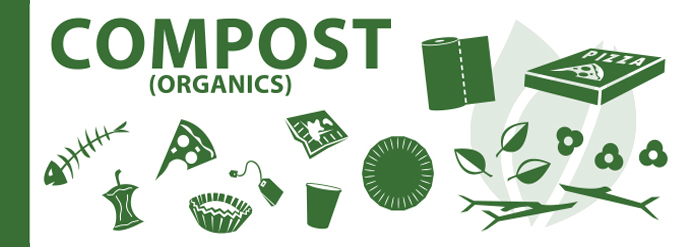Compost Collection
The PSSI Curbside Compost Collection Program Includes:
FOOD SCRAPS
Fresh, frozen, cooked, and moldy.
Use your handy Kitchen Pail to collect food scraps in your home. Click here for Kitchen Pail tips.
All leftover non-edible food, including:
- peels, pits, and rinds
- eggs, eggs shells, and dairy products
- bread, rice, pasta, and other grains
- meats and bones
- coffee grounds and tea leaves
NØ GLASS, METAL, OR PLASTIC.
FOOD-SOILED PAPER
- paper coffee filters and paper tea bags
- paper napkins, towels, plates, and cups
- paper coffee cups that are marked compostable (Please note that most to-go paper beverage cups, to-go containers, and plates are lined with plastic. They are not compostable.)
- food-soiled newspaper and paper bags
- pizza boxes and donut boxes
- Compostable plastics (PLA, Bagasse) that are certified as compostable by BPI.
NØ GLASS, METAL, OR PLASTIC.
YARD TRIMMINGS
- Grass clippings
- Flowers
- leaves
- weeds
- tree trimmings, pruning material, and branches must be LESS THAN 3 inches in diameter*.
NØ PALM FRONDS, SOD, DIRT, BRICK, OR CONCRETE.
CLEAN WOOD
NØ HARDWARE, PAINT, OR STAIN.
NØ TREATED WOOD WASTE.
AVOID THE “ICK FACTOR”. TIPS FOR A SUCCESSFUL FOOD SCRAPS COLLECTION PROGRAM
- Wrap food scraps in newspaper or a paper bag before putting them into the cart. Paper absorbs moisture, odor, and is compostable.
- Layer/cover food scraps with yard trimmings.
- Freeze or refrigerate wrapped food scraps before placing them in the cart and/or place the food scraps in the cart just before collection day.
- Put the cart out weekly for service (even if it isn’t full).
- When the cart is empty, rinse it out on a landscaped area using only water.
PLEASE REMEMBER PROPER SORTING MAKES A DIFFERENCE!
These items will be collected and composted into a soil product. In order for this program to be successful, please make sure we receive compostable materials with no contamination.
NØ GARBAGE , POLYSTYRENE/STYROFOAM®, DIAPERS, PET WASTE, PERSONAL HYGIENE PRODUCTS, GLASS, METAL, PLASTIC, HOT ASHES/COALS* , DIRT, BRICK, CONCRETE, PRESSURIZED TANKS, NEEDLES/SHARPS, OR HAZARDOUS WASTE.
- Place fireplace, stove, and barbecue ashes in a metal container with a tight-fitting lid.
- Put the container with ashes outside – at least 10 feet away from your home and combustibles.
- Wet ashes down. COLD ashes must be contained (in a bag or box), so they do not blow away during collection, and placed in your landfill cart.
For more information and additional fire safety tips:
CONTAMINATION PROCEDURES:
If the compost/organics cart contains any unacceptable items, it will be tagged and will not be collected until the contamination has been removed. Once cleared of contamination, the compost/organics cart will be emptied on the next collection day. Questions? Please contact us.

